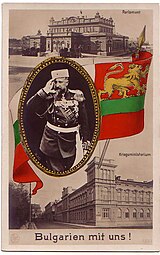Battle of Doiran (1918)
| Battle of Doiran | |||||||
|---|---|---|---|---|---|---|---|
| Part of World War I | |||||||
 1914-1918 British Military Cemetery in Policastron (formerly Karasouli) near Doiran | |||||||
| |||||||
| Belligerents | |||||||
|
|
| ||||||
| Commanders and leaders | |||||||
|
|
| ||||||
| Strength | |||||||
| - 9-th Infantry division, with parts of 11-th Infantry division and the Mountain Division (Total: 35 000)[1] |
- United Kingdom: 4 divisions - Greece: 2 divisions (around 75 000 men)[2] | ||||||
| Casualties and losses | |||||||
| 2,000 total[1] | 14,000 total[1] | ||||||
The third Battle of Doiran was fought from 18 September to 19 September 1918, with the Greeks and the British assaulting Bulgarian positions near Dojran Lake. The battle was part of World War I and took place in the Balkan Theatre. The battle ended with Bulgarians repulsing all attacks, but then retreating.
Prelude
The Greeks and the British set off from their base at Thessaloniki at the same time as the Serbians and the French. The Greeks and the British under George Milne set off the attack on the Bulgarian positions at Dojran while the Serbians and the French under the command of Franchet d'Esperey went to penetrate the Bulgarian defences in the Vardar Valley. The Greeks and the British were aiming to capture the Bulgarian positions in the hills above Dojran Lake.
This wasn't the first time the Allies had attacked Dojran - in 1916 an Anglo-French attempt was repulsed by the Second Thracian Infantry Division; the British had twice failed to capture it in 1917. The fortifications were well built (by Bulgarian engineers), the Bulgarians having spent the first months of 1916 and early 1917 strengthening the positions. The terrain around the area was rough, the fortifications being surrounded with three miles of scrub and rocks. Part of the defences were the dangerous Pip Ridge and the Grand Couronné.
The battle
The first assault on the hills was by the 22nd and the 26th Divisions of the British army with support from the Cretan Division of the Greek army. As they were advancing up the hills they were caught in a crossfire coming from the slopes and were driven back with heavy losses. They then assaulted the Pip Ridge, with the 12th Cheshires leading the attack. The bunkers on the hills that had machine guns in them opened fire and had a horrific effect on the Allies; only 20%-30% of their soldiers reached the trenches, but those that remained continued on and captured the first two Bulgarian trenches.[citation needed]
While this was happening a Greek regiment was knocked back on the right. The South Wales Borderers had reached Grand Couronné, the last line of defence. The bravery of the Welsh was extreme; they charged up the hill trying to get over the defences of the Grand Couronné, only to be cut down. Of the whole battalion only one officer and eighteen men made it back to the camp. The Bulgarians showed great bravery against the enemy, whose forces were 6 times larger than theirs.[2]
Casualties
The Allies' losses totalled about 14,000 soldiers, while the Bulgarians suffered only 2,000.[1] The reason for this was that in the night of September 16 the allies bombarded the Bulgarian positions with heavy artillery fire (the total weight of the bombs is estimated to have been 30,000 t). The Allies believed that there would be few survivors, but due to the well-constructed bunkers the Bulgarians lost only 9 killed and 40 injured. Thus the Allied attack proved to be a complete disaster, as the Greek and the British soldiers were easy targets for the hidden Bulgarians.[citation needed]
Retreat
After a day of fighting all the Allies had accomplished was a small gain on the right by the Greek forces. The next day the 65th Brigade attacked Pip Ridge. The assault was another defeat, with only half of the men returning alive, but the assault gained the town of Dojran and a few hills above it. All these meant nothing to the Bulgarians, however, who only had a small garrison there. After a while the Bulgarian fortifications went quiet and the Greek and British armies advanced only to find the Bulgarian positions abandoned. The Serbian and French armies had defeated the Austro-Hungarian and Bulgarian army in the Vardar valley and were advancing towards Doiran. When the Bulgarians' German advisors heard of this, they ordered the Bulgarian army to retreat so that they would not be cut off from the rear.[2]
Aftermath
The Allies continued to advance deeper into Bulgarian-held territory and some said the Bulgarian army had mutinied and were threatening Sofia. On September 30, the Bulgarians surrendered to the allies in Thessaloniki.[2] The war was costly for Bulgaria, which lost 87,500[citation needed] soldiers killed and 275,000 civilians[citation needed]. The Bulgarians fail to return Macedonia, lost all their land on the Aegean Sea to Greece, territory in the northwest to Serbia and South Dobrudja to Romania.
The Bulgarian military cemeteries in the region have been destroyed.[citation needed]
Trivia
The British paid great honor to General Vladimir Vazov when he arrived in Victoria Station in London, by lowering the flags of all their regiments who participated in the battle. The chairman of the British legion Major Goldy said in his speech: “He is one of the few foreign officers whose name features in our history”.
See also
Footnotes
References
- AJP Taylor. History of World War I. ISBN 0-7064-0398-3
- Атанас Пейчев, 1300 години на стража, Военно издателство София 1981


